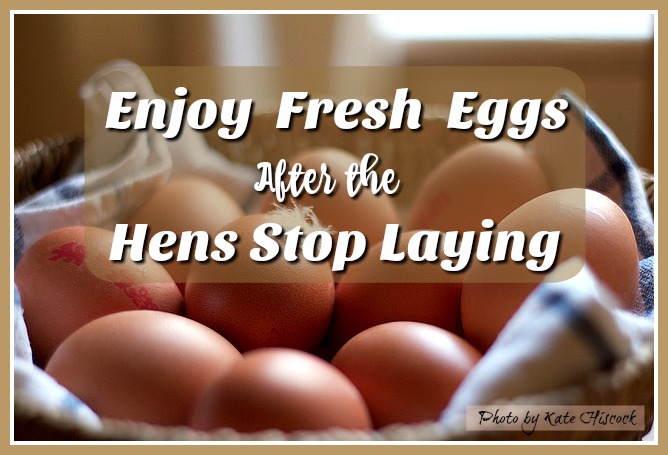
Anyone who’s ever tasted a farm fresh egg knows they’re far superior to eggs sold at the supermarket. Their yolks are more golden and taller. They’re more nutritious because hens raised on a farm have a better diet than commercially raised hens. And it’s comforting to know they come from happy hens that get to enjoy wandering about outdoors, pecking at bugs, playing on swings, and living a natural, stress-free life. Have you ever tried freezing eggs after your hens stop laying for the season?
Stock Up on Eggs While You Can!
If you’ve become accustomed to farm fresh eggs, you probably dread the thought of ever eating another supermarket egg again. But with the daylight hours getting shorter as the cold weather approaches, the girls won’t be laying as many eggs, or perhaps none at all. Don’t worry, though, you can still savor the eggs you’ve come to love!
If you have a source of farm raised eggs, STOCK UP NOW! There’s an easy way to freeze fresh eggs so you can keep on enjoying them long after the girls stop laying. All you need is some ice cube trays and/or muffin pans and a can of regular, unflavored Pam.
How to Freeze Eggs Individually
Sometimes you need just one egg. Or, maybe you need several eggs, but they have to be kept separate. Be sure to freeze some eggs individually for these occasions.
Ice cube trays work great for freezing eggs individually, unless the eggs are extra large. (For oversize eggs, you’ll need to use a muffin pan and follow the instructions in the “How to Freeze Several Eggs Together” section, below.)
Spray an ice cube tray generously with Pam. Crack an egg into each compartment of the ice cube tray. Add a small pinch of salt or sugar to each compartment to help preserve the texture the eggs after they’re thawed. Then, place the ice cube tray in the freezer. Label a Ziploc bag or airtight freezer container with the date, and whether salt or sugar was added. When the eggs are frozen solid, pop them out of the ice cube tray and place them in the labeled freezer bag. Then, place the bag in the freezer for long-term storage. If you’re concerned the individual eggs might stick together, you can slip each one into its own sandwich baggie before placing it in the freezer bag.
Please note:
Remember that liquids expand when frozen, so be sure to leave enough “head room.” If your egg fills the ice cube tray compartment right up to the top, you’ll need to use a muffin pan instead.
How to Freeze Several Eggs Together
When baking, making pancakes, or preparing an omelet or scrambled eggs for more than one person, you’ll need several eggs. For purposes like these, the eggs don’t need to be kept separate. Freezing two or more eggs together saves time. It’s also more economical because you use fewer baggies. And, it’s more convenient because you’ll have larger portions on hand when you need them.
You can use muffin pans much like ice cube trays. Muffin pans offer the advantage of allowing you to freeze more than one egg per compartment, if desired. Depending on the size of your eggs, each compartment can hold as many as three. Again, remember to allow “head room” in the compartment for expansion.
Spray a muffin pan generously with Pam. Crack two or three eggs (as desired) into each compartment of the muffin pan. Add a pinch of salt or sugar to each compartment to help preserve the texture the eggs after they’re thawed. Then, place the muffin pan in the freezer. Label a Ziploc bag or airtight freezer container with the date, the number of eggs per package, and whether salt or sugar was added. When the eggs are frozen solid, pop them out of the muffin pan and place them in the freezer bag. Then, place the bag in the freezer for long-term storage. If you’re concerned the eggs portions might stick together, you can slip each one into its own sandwich baggie before placing it in the freezer bag.
Defrosting Frozen Eggs
Take as many eggs as you’ll need out of the freezer, allowing enough time for them to thaw in the refrigerator. Letting your eggs slowly in the refrigerator seems to preserve their integrity better. Some folks claim previously frozen eggs don’t provide as much leavening in baked goods, so you might want to keep that in mind and adjust your recipe accordingly.
Other Ways to Freeze Eggs
If you need to separate your eggs, the whites and yolks can be frozen separately. Egg whites alone freeze very well and don’t require any added salt or sugar. After thawing, you can whip previously frozen egg whites just like fresh ones to make meringues, angel food cakes, and so on.
Like whole eggs, egg yolks don’t freeze especially well unless you add a little salt or sugar to keep them from clumping together into a blob. To freeze egg yolks, blend them first. Then add 1/2 teaspoon of salt or 1 tablespoon of sugar per cup of blended whole eggs.
Store separated eggs in a Ziploc bag or airtight freezer container. If using a bag, press out as much air as you can before placing it in the freezer.
Have you ever tried freezing eggs? If so, how did they turn out? Tell us about your experiences using previously frozen eggs in the comments at the very bottom of this page!
Authored by: Anna Paige
(c) 2016 Homesteader’s Supply
